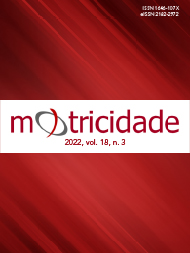Team cohesion and group conflict in Brazilian youth athletes: study based on achievement goals theory
DOI:
https://doi.org/10.6063/motricidade.25937Palavras-chave:
Youth Athletes, Group Environment, Goals, Team Cohesion, Sports PsychologyResumo
The present study investigated the cohesion of teams and group conflict, based on the theory of compliance goals, in young Brazilian athletes participating in the final phase of the School Games in the state of Pernambuco. The participants were 413 young athletes, boys (n= 227) and girls (n= 186) aged between 14 and 17 years. Participants completed self-report questionnaires to assess the Youth Sport Environment Questionnaire (P-YSEQ), Group Conflict Questionnaire (P-GCQ) and Task and Ego Orientation in Sport Questionnaire (TEOSQ). The data were analyzed using hierarchical and non-hierarchical cluster analysis, chi-square test, multiple regression and multivariate variance analysis (MANOVA). The results showed that task orientation made the largest positive contribution to both task (β= .50, p< .001) and social (β= .31, p< .05) cohesion. Ego orientation made the largest positive contribution to task conflict (β= .49, p< .001) and social conflict (β= .67, p< .001), whilst task orientation made a negative contribution (β= -.34, p< .05) for social conflict. Compared to the high task and low ego cluster (Cluster 3) was compared with low ego and task (Cluster 2) and high task and low ego cluster (Cluster 1), there was a significant difference between groups in task cohesion (p= .001), task conflict (p= .003) and social conflict (p= .001). It is concluded that task orientation seems to be a positive predictor of team cohesion, while ego orientation might predict positively group conflict and negatively task cohesion.
Downloads
Publicado
Edição
Secção
Licença
Os autores dos manuscritos submetidos para publicação deverão ceder, a título integral e permanente, os direitos de autor (copyright) à revista Motricidade e às Edições Sílabas Didáticas. A cedência de direitos de autor permite a publicação e divulgação do artigo em formato impresso ou eletrónico e entrará em vigor a partir da data de aceitação do manuscrito. Os autores concedem, ainda, os direitos para a revista Motricidade utilizar e explorar o respetivo artigo, nomeadamente para licenciar, ceder ou vender o seu conteúdo a bases de resumos/indexação ou outras entidades.
Nos termos da licença “Creative Commons”, os autores poderão reproduzir um número razoável de exemplares para uso pessoal ou profissional, mas sem fins comerciais. Nos termos da licença SHERPA/RoMEO, os autores poderão, ainda, disponibilizar/arquivar uma cópia digital final (versão postprint) do artigo no seu website ou no repositório científico da sua instituição.


